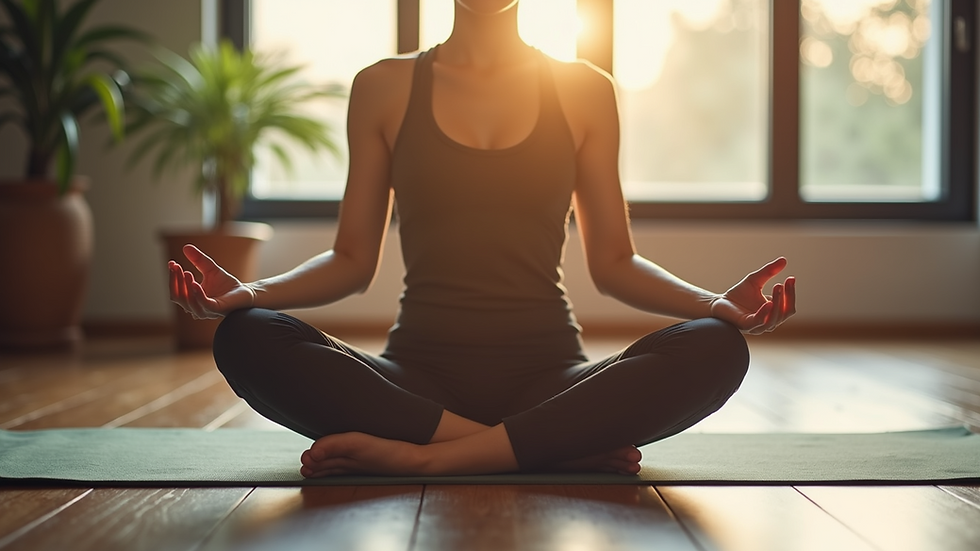Using Meditation to Combat Anxiety
- frenchbulldogs777
- Sep 29
- 4 min read
Anxiety is a common challenge that affects millions of people worldwide. It can disrupt daily life, making it difficult to focus, sleep, or enjoy activities. Fortunately, meditation offers a powerful tool to manage and reduce anxiety symptoms. This blog post explores how meditation can help calm the mind, improve emotional balance, and provide practical steps to incorporate meditation into your routine.
Understanding Meditation to Reduce Anxiety
Meditation is a practice that involves focusing the mind and eliminating distractions to achieve a state of mental clarity and emotional calm. When anxiety strikes, the mind often races with worries and fears. Meditation helps by training the brain to stay present and observe thoughts without judgment.
There are many types of meditation, but mindfulness meditation is particularly effective for anxiety. It encourages awareness of the present moment, helping you recognize anxious thoughts as temporary and not necessarily true. This shift in perspective can reduce the intensity of anxiety.
How Meditation Works for Anxiety
Reduces stress hormones: Meditation lowers cortisol levels, the hormone linked to stress.
Improves brain function: It enhances areas of the brain responsible for emotional regulation.
Promotes relaxation: Deep breathing and focused attention activate the parasympathetic nervous system, which calms the body.
Increases self-awareness: You become more aware of triggers and patterns that cause anxiety.
By practicing meditation regularly, you can build resilience against anxiety and improve overall mental health.

Practical Meditation Techniques to Reduce Anxiety
Starting meditation can feel overwhelming, but simple techniques can make it accessible and effective. Here are some easy methods to try:
1. Mindful Breathing
Focus your attention on your breath. Notice the sensation of air entering and leaving your nostrils or the rise and fall of your chest. When your mind wanders, gently bring it back to the breath.
Sit comfortably with your back straight.
Close your eyes or soften your gaze.
Breathe naturally and observe each breath.
Practice for 5-10 minutes daily.
2. Body Scan Meditation
This technique helps you connect with your body and release tension.
Lie down or sit comfortably.
Slowly bring attention to each part of your body, starting from your toes up to your head.
Notice any sensations, tightness, or discomfort without trying to change them.
Breathe into areas of tension and imagine them softening.
3. Guided Meditation
Using audio or video guides can help beginners stay focused.
Choose a meditation app or online resource.
Follow the instructions and allow yourself to relax.
Guided sessions often include calming music or nature sounds.
4. Loving-Kindness Meditation
This practice cultivates compassion and reduces negative emotions.
Repeat phrases like "May I be safe, may I be happy, may I be healthy."
Extend these wishes to others, including those you find challenging.
Consistency is key. Even a few minutes daily can lead to noticeable improvements in anxiety levels.

Tips for Creating a Meditation Routine
Building a meditation habit requires intention and a supportive environment. Here are some tips to help you get started and stay motivated:
Choose a quiet space: Find a place free from distractions where you feel comfortable.
Set a regular time: Meditate at the same time each day, such as morning or before bed.
Start small: Begin with 5 minutes and gradually increase the duration.
Use reminders: Set alarms or notes to prompt your practice.
Be patient: Meditation is a skill that improves with practice; don’t judge yourself for wandering thoughts.
Combine with other healthy habits: Exercise, healthy eating, and adequate sleep enhance meditation benefits.
Remember, meditation is not about stopping thoughts but learning to observe them without getting caught up.
The Science Behind Meditation and Anxiety Reduction
Research supports the effectiveness of meditation in managing anxiety. Studies show that regular meditation can:
Decrease symptoms of generalized anxiety disorder (GAD).
Reduce panic attacks and social anxiety.
Improve emotional regulation and stress response.
One study found that mindfulness meditation reduced anxiety by changing brain activity in the amygdala, the area responsible for fear and stress. This change helps people respond to anxiety triggers more calmly.
For those seeking professional support, combining meditation with therapy can be highly effective. Resources like the Trauma and Anxiety Center of Tampa offer guidance on integrating meditation and anxiety reduction into a comprehensive treatment plan.

Incorporating Meditation into Daily Life Beyond Formal Practice
Meditation is not limited to sitting quietly for a set time. You can bring mindfulness into everyday activities to reduce anxiety throughout the day:
Mindful walking: Pay attention to each step, the sensation of your feet touching the ground, and your surroundings.
Mindful eating: Savor each bite, notice textures and flavors, and eat slowly.
Mindful listening: Focus fully on conversations without planning your response.
Pause and breathe: Take short breathing breaks during stressful moments.
These small moments of mindfulness can interrupt anxious thought patterns and create a sense of calm.
Moving Forward with Meditation for Anxiety Relief
Meditation offers a natural, accessible way to manage anxiety. By understanding its benefits, practicing simple techniques, and integrating mindfulness into daily life, you can build resilience and improve your emotional well-being.
If anxiety feels overwhelming or persistent, consider seeking professional help. Combining meditation with therapy or counseling can provide a comprehensive approach to healing.
Explore more about meditation and anxiety reduction to find resources and support tailored to your needs. With patience and practice, meditation can become a valuable tool on your journey to a calmer, more balanced life.






Comments